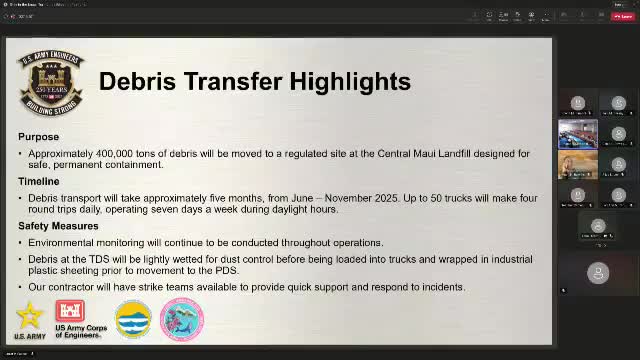Maui officials outline debris transfer plans amid environmental monitoring efforts
June 04, 2025 | Maui County, Hawaii
This article was created by AI summarizing key points discussed. AI makes mistakes, so for full details and context, please refer to the video of the full meeting. Please report any errors so we can fix them. Report an error »

The Maui County Water and Infrastructure Committee convened on June 4, 2025, to discuss critical updates regarding debris management and environmental monitoring following recent wildfires. The meeting focused on the phased approach to debris transfer and restoration, as well as the collaborative efforts among various agencies to ensure public health and safety.
The session began with a presentation outlining the three-phase plan for debris management. The first phase involves protecting and monitoring the temporary debris site, which is set to transition to the careful transfer of debris starting June 16. Following this transfer, restoration efforts will commence, aiming to return the site to its original condition or an agreed-upon state with the county.
Key logistical details were shared regarding the routes for debris transport. The primary route, highlighted in red on a provided map, will utilize Hawaii 30 and Highway 380, with two alternate routes available should any closures occur. The committee emphasized efforts to minimize traffic disruption, with a target completion date set for the end of November. Monitoring of traffic flow will be conducted to ensure minimal impact on the community.
Nancy Conrad from the Department of Health provided an update on environmental monitoring efforts. She acknowledged the successful collaboration with local, state, and federal partners, including the Corps of Engineers and FEMA. The monitoring program has yielded no significant adverse findings regarding air quality, heavy metals, or water safety, reinforcing the effectiveness of previous mitigation measures. Permanent air monitoring stations will remain operational in key areas, including Kihei, to ensure ongoing oversight.
Shane Agawa from the Department of Environmental Management elaborated on the selection process for the permanent disposal site (PDS) at the Central Maui Landfill. He detailed the collaborative efforts that led to the final site selection, which involved input from community surveys and a scoring matrix to evaluate potential locations based on logistical and regulatory criteria. The committee highlighted the importance of public input in shaping the decision-making process.
The meeting concluded with a commitment to continue monitoring and adjusting strategies as necessary to protect public health and ensure the effective management of debris. The committee plans to keep the community informed as operations progress and further updates become available.
The session began with a presentation outlining the three-phase plan for debris management. The first phase involves protecting and monitoring the temporary debris site, which is set to transition to the careful transfer of debris starting June 16. Following this transfer, restoration efforts will commence, aiming to return the site to its original condition or an agreed-upon state with the county.
Key logistical details were shared regarding the routes for debris transport. The primary route, highlighted in red on a provided map, will utilize Hawaii 30 and Highway 380, with two alternate routes available should any closures occur. The committee emphasized efforts to minimize traffic disruption, with a target completion date set for the end of November. Monitoring of traffic flow will be conducted to ensure minimal impact on the community.
Nancy Conrad from the Department of Health provided an update on environmental monitoring efforts. She acknowledged the successful collaboration with local, state, and federal partners, including the Corps of Engineers and FEMA. The monitoring program has yielded no significant adverse findings regarding air quality, heavy metals, or water safety, reinforcing the effectiveness of previous mitigation measures. Permanent air monitoring stations will remain operational in key areas, including Kihei, to ensure ongoing oversight.
Shane Agawa from the Department of Environmental Management elaborated on the selection process for the permanent disposal site (PDS) at the Central Maui Landfill. He detailed the collaborative efforts that led to the final site selection, which involved input from community surveys and a scoring matrix to evaluate potential locations based on logistical and regulatory criteria. The committee highlighted the importance of public input in shaping the decision-making process.
The meeting concluded with a commitment to continue monitoring and adjusting strategies as necessary to protect public health and ensure the effective management of debris. The committee plans to keep the community informed as operations progress and further updates become available.
View full meeting
This article is based on a recent meeting—watch the full video and explore the complete transcript for deeper insights into the discussion.
View full meeting
